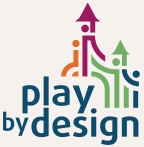Imagine a beautiful place carefully designed for elders to exercise, socialize, and play: a wellness playground for elders.
Play By Design has helped hundreds of grass-roots community groups in the U.S. and oversees create outstanding children’s playgrounds.
In 2010, our team also began designing innovative playgrounds to meet the needs of elders for attractive and effective places to exercise, socialize, and play.
Our elders’ playgrounds are appealing, accessible and safe spaces where older adults will enjoy spending time and which encourage physical & mental exercise, social interaction and playfulness.
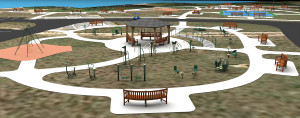
Exercise
The health benefits of exercise for elders are many and well known. An abundance of studies confirm that regular exercise helps to:
– Prevent falls and fractures
– Reduce the risk of strokes, heart disease, and some cancers
– Lessen cognitive decline
– Control obesity, diabetes, and high blood pressure
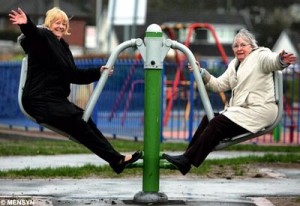 The World Health Organization recommends adults 65 and older should do at least 150 minutes of moderate-intensity aerobic physical activity throughout the week or do at least 75 minutes of vigorous intensity aerobic physical activity throughout the week or an equivalent combination of moderate-and vigorous-intensity activity.
The World Health Organization recommends adults 65 and older should do at least 150 minutes of moderate-intensity aerobic physical activity throughout the week or do at least 75 minutes of vigorous intensity aerobic physical activity throughout the week or an equivalent combination of moderate-and vigorous-intensity activity.
Our designs target the therapeutic exercises most important for the ability of elders to stay actively engaged daily:
– Extending range of motion
– Improving balance
– Building muscle strength
– Promoting cardiovascular health
– Enhancing fine motor coordination
Socialize
Social activity promotes wellness, confidence and joy. It wards off social isolation, which can lead to loneliness and depression.
A 2007 Cornell University study, Social Isolation: Strategies for Connecting and Engaging Older People notes that about 30 percent of elders over 65 in America live alone, adding that “Baby Boomers are projected to experience greater social isolation given their lower rates of marriage, high levels of divorce, and fewer children.” (Cornell Institute for Translational Research on Aging, March 2007)
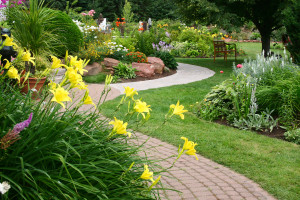
Our playgrounds for elders deliberately encourage social interaction and engagement.
– Safe, attractive and peaceful gardens, with shelters, conversational seating nooks, and wide walking paths
– Activity equipment designed for face-to-face usage
– Games like chess, cards, bocce and ping-pong
– Spaces for yoga or tai chi
– Acoustic performance spaces for both observing and performing
Play
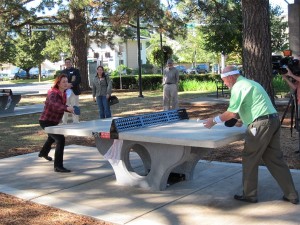
The myriad benefits of physical exercise and social interaction are multiplied and deepened by providing such opportunities in a playful, lighthearted setting.
Playing relieves stress and improves mood.
By designing the whole experience to be enjoyable and playful, elders will visit, participate, and return, often inviting friends and family.
“Wellness Parks for Seniors: Serious Play”
Donald A. Rakow
The Voice, New York State Recreation and Park Society, Winter 2016
Play. It’s that series of activities that a child delights in and uses to hone their motor skills, social abilities, and sense of self. But is play the sole domain of kids? Michael Cohen, longtime playground designer and member of the staff at Play by Design, doesn’t think so.
Cohen was inspired to address the recreational needs of seniors after viewing a video of a playground for elders in Manchester, England. He was struck by the delight on the older residents’ faces, and immediately recognized a need that was not being met in this country. We build housing and community centers for seniors, so why do we ignore the value of outdoor exercise?
Researching the topic further, Cohen learned that the Chinese and other Asian societies have long addressed this need by providing outdoor gyms for elders in the communities where they live. Since the 1990’s, the concept has spread to a number of European countries and one site in British Columbia. But Cohen was frustrated by the lack of interest in the U.S.
In response, Cohen has designed wellness parks that address two critical needs of older populations: exercise to remain healthy and limber and socializing to prevent isolation. His designs include adaptive exercise equipment, some of which he’s developed and some which is based on prototypes from Asia or Europe. He blends the built features with trees and other plantings to make the sites shady and attractive, while avoiding secluded corners that could feel insecure to seniors. Cohen’s vision “is a park or garden that is inviting. A place that has a serenity, lightheartedness about it.”
As Cohen sees it, seniors enjoy being challenged by new workout modes, but must feel confident that they won’t be embarrassed by an apparatus they can’t control. He addresses this issue in two ways- by ensuring that pieces of equipment are low impact with minimal opportunities for failure, and by placing benches within sight of equipment, so bench sitters can see how easily peers master the gear.
But what about those geriatric individuals with limited mobility or in wheelchairs? Cohen has incorporated game tables to accommodate wheelchairs, and exercise machines that can be accessed from a seated position. And by minimizing grade changes and avoiding steps, senior playgrounds can be made accessible to most individuals.
For parks managers, designating a recreational area specifically for seniors can present challenges, and it isn’t Cohen’s intention to exclude children from playing in them. But he has found that so called ‘multi-generational’ playgrounds tend to focus on the needs of kids to the exclusion of elders. Slides, see-saws, and traditional swings simply aren’t safe for older generations.
And safety, certainly, is a major issue. While working out on equipment in a senior park can improve one’s balance and range of motion, special concern needs to be taken when individuals with cognitive impairments are present. Cohen regularly seeks the input and advice of gerontology experts, many of whom are members of the impressive board he’s built to guide him in this process. But he feels that persons with Alzheimer’s or similar conditions are most often accompanied by a caregiver and thus unlikely to harm themselves or wander away from the park. The goal is to get every senior outside, regardless of their physical or mental capacities.
The process of getting Americans to awaken to the outdoor recreational needs of seniors has been a slow one, and Cohen is hopeful that the first of the wellness parks he’s designed will be constructed this coming spring. But simply by raising this neglected issue, he has demonstrated yet another way that our parks and recreational areas can provide for greater health and wellness throughout an individual’s lifespan.
Playground for an Aging Population
The idea: Outdoor exercise is good for older adults both physically and mentally
By BETH HOWARD
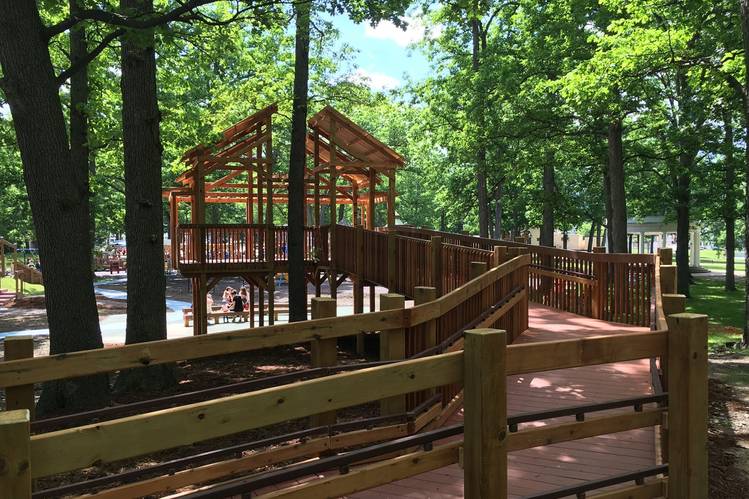
Wellness Parks for Seniors: Serious Play
By Donald A. Rakow
NYSRPS The Voice Winter/Spring 2016
Pages 30-31
